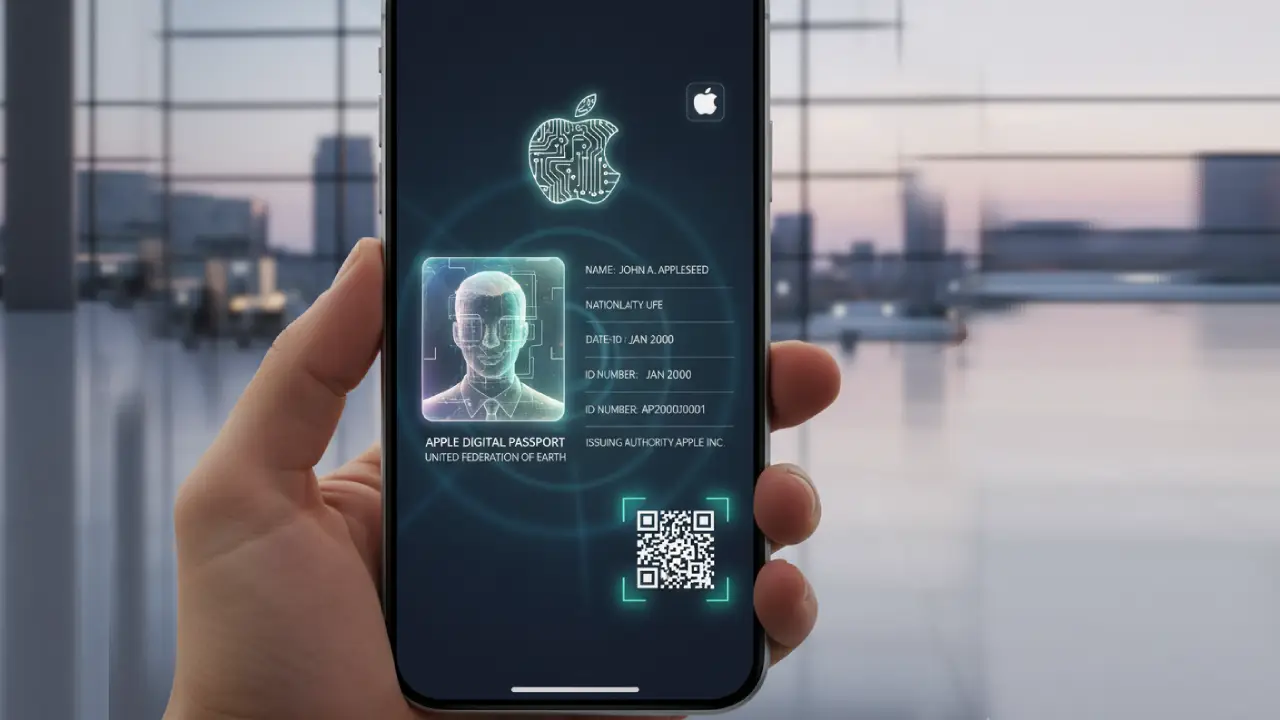A Strategic Analysis of Apple’s Passport-Derived Digital ID in Wallet

A Strategic Analysis of Apple’s Passport-Derived Digital ID in Wallet

The Architecture of Trust
Apple’s Digital ID, branded as ID in Wallet, represents a landmark in mobile identity verification for U.S. citizens. This feature converts a federal credential—the U.S. passport—into a secure, device-bound digital credential that can be presented via iPhone or Apple Watch. Users can leverage this credential for domestic verification tasks, including travel, age confirmation, and online identity validation.
Launched in November 2025, the passport-derived Digital ID builds on Apple’s prior integration of state-issued driver’s licenses into Wallet, which began in 2022. Unlike the fragmented state mDL rollout, the Digital ID leverages the universally recognized U.S. passport to achieve immediate national coverage. By circumventing the slow, state-by-state approach, Apple provides a unified, federally backed identity solution accessible to millions.
The Digital ID’s initial deployment is focused on TSA checkpoints, with acceptance at over 250 U.S. airports. It is important to note that this credential does not replace a physical passport for international travel, border crossings, or U.S. re-entry; users must maintain their original document for these purposes.
Foundational Technology and Enrollment Protocols
A. Technical Requirements and Device Compatibility
The Digital ID relies on advanced hardware and software to maintain high-security standards. Eligible devices include iPhone 11 or later running iOS 26.1+, and Apple Watch Series 6 or later running watchOS 26.1+. Users must enable Face ID or Touch ID, activate Bluetooth for short-range presentation, and maintain an Apple account secured with two-factor authentication. A valid, unexpired U.S. passport is required as the source document.
These stringent requirements ensure the Digital ID is cryptographically and biometrically bound to a modern device capable of executing sophisticated identity verification processes.
B. High-Assurance Identity Proofing (IAP) Enrollment
Enrollment is multi-layered, designed for maximum assurance and fraud prevention:
- Document Scan: Users scan the machine-readable zone of their passport.
- NFC Chip Authentication: The iPhone reads the passport’s embedded NFC chip, verifying cryptographic integrity.
- Liveness Detection & Biometric Binding: Users perform facial and head movements to confirm liveness, linking the credential to current biometrics.
- Issuing Authority Approval: Data is sent to the federal authority for verification before provisioning the Digital ID.
By integrating NFC chip reads, Apple ensures that the digital credential mirrors the integrity of the physical passport, complying with international security standards such as ISO 18013-5 for mobile credentials.
| Requirement | Passport-Based Digital ID | State-Issued Driver’s License/ID |
| Device | iPhone 11+ | Varies (iPhone 8+ typical) |
| OS | iOS 26.1+ | Varies (iOS 15.4+ typical) |
| Credential | Valid U.S. Passport | Eligible State License/ID |
| Verification | Scan + NFC + Liveness + Biometric | Scan + Biometric Check |
| Core Security | Secure Element + Face/Touch ID | Secure Element + Face/Touch ID |
Digital ID Acceptance Ecosystem
A. Anchoring Acceptance: TSA Use Case
The TSA is the primary driver for early adoption. The Digital ID allows travelers to present a passport-based credential securely without handing over their device. Authentication occurs via Face ID or Touch ID, and users retain full control of their personal data. This provides a seamless experience while satisfying domestic security requirements, including compliance with the REAL ID Act.
B. Expanded Verification Spectrum
Beyond air travel, Apple envisions broader use across businesses, venues, online platforms, and in-app identity checks. The "Verify with Apple Wallet" framework allows verified, government-backed credentials to be shared selectively, facilitating age checks, rentals, and financial transactions with minimal friction.
C. Global Standardization and Future Ambitions
The architecture aligns with ISO 18013-5, indicating Apple’s long-term aim of global interoperability. Although currently restricted to domestic use, the underlying technology could eventually support international travel, contingent on regulatory agreements.
| Use Case | Acceptance Status | Notes |
| Domestic Air Travel | Accepted (Beta) | 250+ airports; domestic use only |
| International Travel | Not Accepted | Physical passport required |
| Age/Identity Verification (In-Person) | Select venues | Requires compatible readers |
| Online/App Verification | Supported via API | Streamlined KYC transactions |
| REAL ID Compliance | Implicitly satisfied | Bypasses state-level limitations |
Security, Privacy, and Trust Architecture
A. Cryptographic Foundations
The Digital ID relies on the iPhone’s Secure Element, a dedicated chip storing cryptographic keys, to prevent unauthorized access. Credentials are device-bound, making cloning or replay attacks virtually impossible. This mirrors Apple Pay’s security architecture.
B. Privacy by Design
Apple emphasizes user control and data minimization:
- Consent: Presentations require explicit approval via biometrics.
- Selective Data Sharing: Users authorize only necessary information (e.g., age verification without revealing full DOB).
- Non-Tracking: Neither Apple nor issuing authorities can monitor usage patterns. Transaction history remains encrypted on the device.
C. Data Handling During Enrollment
During setup, limited data is temporarily shared for verification purposes:
| Data Point | Issuing Authority | Apple | Verifier |
| Passport Images | Yes | Temporary subset | No |
| Biometric Video | No | Temporary fraud check | No |
| Face/Touch ID | No | No | No |
| Transaction History | No | No | No |
| Minimal Identity (DOB, Name) | Yes | No | Yes (user consent) |
This ensures transparency while maintaining privacy.
Strategic Market Positioning and Future Expansion
Apple’s Verify with Wallet API allows businesses to integrate seamless identity verification into apps and websites, expanding beyond airport use. By providing government-verified credentials, Apple reduces friction, increases transaction efficiency, and positions Wallet as a comprehensive identity and access platform.
By controlling both the infrastructure and verification protocols, Apple gains significant leverage over competitors. However, this centralization raises questions about vendor lock-in, governance, and accountability, requiring ongoing regulatory oversight to ensure consumer rights and security are protected.
Regulatory, Policy, and Ethical Considerations
A. Function Creep and Ubiquitous Identification
Civil liberties groups caution that easy digital ID presentation could normalize constant identification, reducing opportunities for anonymity in public and commercial settings. The convenience of Digital ID carries societal trade-offs that must be carefully managed.
B. Immature Legal Guardrails
The rapid deployment of private-sector digital IDs has outpaced comprehensive legislation. Policymakers need to define:
- Limits on data collection by platform providers
- Rules for mandatory or optional acceptance
- Mechanisms for consumer recourse
- Law enforcement interactions with mobile credentials
Without robust frameworks, citizens could face unregulated digital surveillance under the guise of convenience.
Conclusion
Apple’s passport-derived Digital ID represents a transformative step in U.S. digital identity, strategically bypassing state-level fragmentation and providing a nationally recognized, high-assurance credential. The combination of NFC verification, liveness detection, and Secure Element protection ensures a secure and trustworthy system.
Long-term success depends not only on technical sophistication but also on balancing privacy, regulatory oversight, and ethical deployment. Apple’s privacy-by-design principles protect users, but centralization raises important questions about governance. Proactive legislation and careful monitoring will be essential to ensure that the convenience of digital ID does not come at the cost of personal freedoms.
As the platform evolves, it could form the foundation for global digital identity standards, potentially redefining the future of travel, commerce, and secure online interactions.







